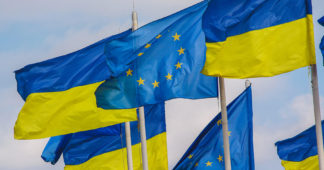July 1, 2024
How should we interpret the results of the EU parliamentary elections?
In Croatia the voter turnout was only 21.35%
The first observation: in the EU elections held in all 27 member countries between 6 and 9 June 2024, voter turnout was once again very low. The average for the entire European Union was 51%. But keep in mind that countries where voting is compulsory also figure into the calculation of that average – for example Belgium, where voter turnout was 90%. [1] Without those countries, the rate of participation in the election would drop below the 50% mark. Out of the 27 EU member countries, 15 had a voter turnout of less than 50%. And the countries who recently joined the EU the rates were extremely low. In Croatia the voter turnout was only 21.35%. Croatia only joined the EU in 2013, and did not become part of the Eurozone and the Schengen Area until 2023. In Lithuania, which joined the EU in 2004, the voter turnout was 28.35%. For the two other Baltic republics, the rate was 34% for Latvia and 37.6% in Estonia. The other countries where participation in the election was low are: the Czech Republic with 36.45%, Slovakia at 34.40%, Portugal with 36.5%, Finland with 40.4, Bulgaria with 33.8% and Greece with 41.4% (and remember that voting is compulsory in the latter two!). Italy’s rate (48,3%) was six percentage points lower than in 2019. In France, the turnout was 51.50%. Among the major countries of the European Union, only Germany is well above the 50% turnout mark, with 65%.
Conclusion : the majority of European Union citizens have no enthusiasm for the EU institutions and don’t see the point in exercising their right to vote. Citizens of the countries of the former Eastern Bloc or Southern Europe, who were full of hope when their countries became part of the EU or later the Eurozone or the Schengen Area are clearly disappointed by the promises of improved quality of life that have not come true. Hopes of progress in the area of social rights have not materialized – quite to the contrary. Whilst it sometimes adopts a few relatively positive resolutions, the European Parliament has no real power. It is the EU Commission and Council who make the real decisions; and the major countries like Germany and France have decisive influence there. And don’t forget the coercive role played by the European Central Bank on several occasions, as in the case of Greece in 2015, where it used its power to destabilize a government that was not docile enough in following the policies set by the EU’s real leaders. Those policies are forced on the populations by the governments of the countries who dominate the EU economically and politically and by the major private corporations, in particular big private banks and investment funds. Citizens also realized during the coronavirus pandemic (2020–2021) that the EU’s leaders were incapable of adopting health policies that could protect them effectively. And since then, the EU has done nothing to improve the situation structurally – refusing to put in place a pharmaceutical industry capable of responding to a new pandemic, refusing to support the proposal of 135 countries of the Global South to suspend application of patents, barring universal access to vaccines and instead supporting Europe’s arms industry by increasing military spending.
The conservative Right and the extreme Right have emerged greatly strengthened
Second observation: political forces of the conservative Right and Far Right have emerged greatly strengthened. Political groups who promoted themselves as being centrist or centre-right, despite their conducting hard-right policies regarding migrants, candidates for asylum and the accelerated remilitarization of Europe, are reeling from heavy losses in certain cases. That is especially true of the group centred around the party of Emmanuel Macron, Renaissance, which lost 10 seats, dropping from 23 to 13. Another example is Open VLD and the Belgian Prime Minister Alexander De Croo, who lost half their seats. Voters prefer the original (the Far Right or hard conservative Right) to a pale imitation.
The other big losers are the European Greens, who paid for their compromises regarding climate change, the environmental crisis and managing migration and the right to asylum. They also paid for their support for the remilitarization of Europe and alignment with NATO. On certain occasions the Greens have played a fundamental role in forming majorities in the Parliament and the approval of the principal measures of the 2019–2024 legislature (the European Green Deal, the remilitarization of Europe, the Migration and Asylum Pact, etc.). In their respective countries, for example in Germany and Belgium, the Greens have been accomplices to rightist policies. As Miguel Urban writes: “While in 2019 they had won recognition, to a certain extent, as forces for renewal and modernization of a bipartisan governance that had become ineffectual, their inability to meet expectations caused them to pay a high electoral cost.” [2] The European Greens group lost 17 seats, going from 71 to 54 seats. The Greens group was the fourth-largest one in the European Parliament, ahead of the two extreme Right groups ECR and ID (see below). It is now in sixth place. The two extreme-Right groups are now ahead of them.
The dominant group in the European Parliament, the European People’s Party, in which the CDU-CSU of Ursula von der Leyen and the Spanish PP predominate, is tempted to reach out to Giorgia Meloni and her extreme-Right party
Third observation: the coalition of three parliamentary groups that governs the European institutions has held on to a majority, even though it has dwindled from 417 to 406 seats, and can continue to govern the EU. That coalition includes the European People’s Party; the “social-democrat” group of Socialist parties; and Renew Europe (which includes Emmanuel Macron’s Renaissance, Open VLD of Alexander de Croo – who resigned on the evening of the election following his party’s defeat –, and the VVD of Mark Rutte, Holland’s ex-Prime Minister. But the dominant group in the European Parliament – the European People’s Party, in which the CDU-CSU of Ursula von der Leyen and the Spanish PP predominate – is clearly tempted to reach out to Giorgia Meloni and her extreme-Right party Fratelli d’Italia (a member of the ECR parliamentary group) in order to include Italy in Europe’s governance. Meloni, for her part, is bolstered by her own electoral success on 9 June by the growth of the extreme Right parliamentary group, which she leads and which has gone from 69 MEPs to 83. She is demanding a place among the among the top EU leaders, arguing that Renew Europe has dropped from 102 to only 75 MEPs. We’ll know in late June whether she gets her wish.
The “radical Left” group has gained strength overall, going from 37 seats to 39
Fourth observation: the “radical Left” group – the smallest group in the European Parliament – despite losses in some countries such as Portugal, where both the Left Bloc and the PCP lost almost half their votes and seats, has gained strength overall, increasing from 37 to 39 seats. It could grow further, as the Non-attached Members and independents, who represent more than 80 MEPs, could join it. Beyond the composition and the number of the radical Left group The Left, certain successes should be noted. La France Insoumise, for example, did well compared to its 2019 results: the party went from 7 to 9 MEPs, with almost 10% of the vote. We should also add the results of the radical Left in Belgium, with the Workers’ Party of Belgium (PTB) doubling its score and its representation in the EU Parliament (see below). Italy is also a case in point, where the Green and Left alliance reached nearly 7% of the vote and won two EU Parliament seats (see below).
Fifth observation: the crisis of political systems continues to be reflected, in addition to the strengthening of the far Right, by the emergence and success of short-lived lists who take advantage of their impact on the social networks and the voters’ desire for alternatives outside traditional or even “classic” far-Right political parties. Two examples of this phenomenon: the list of Fidias Panayiotou, a 24-year-old Cypriot TikToker, which ranked third and won a seat in the European Parliament with almost 20% of the vote, and Alvise Pérez, the candidate of Se Acabó La Fiesta (The Party is Over), one of Spain’s new parties, which won three seats with 800,000 votes. Alvise Pérez is very active on the social networks Telegram and Twitter / X, where they spread clearly right-wing oriented fake news. Recently, X withdrew his access to the network. He is targeted by several criminal proceedings for defamation and hopes to take advantage of his status as an MEP to dodge them during his term of office.
How much stronger has the far Right become?
The far Right has succeeded in becoming the leading political force in Italy (Fratelli d’Italia), France (RN), Hungary (Fidesz-Hungarian Civic Union), the Netherlands (Geert Wilders’s PVV – Partij voor de Vrijheid) and Austria (FPÖ)
The two far-Right EU Parliament groups, which together numbered 118 MEPs in 2019, have emerged stronger from the 2024 elections. They now have 134 MEPs. The total is 149 if we include the 15 MEPs from Germany’s far-right Alternative for Germany (AfD), which was expelled from the Identity and Democracy (ID) group dominated by Marine Le Pen’s RN in May 2024, following pro-Nazi statements by its main candidate during the European election campaign. It should be noted that on 9 June 2024, AfD became the second-largest political force in Germany with 15 MEPs, whereas in the 2019 European elections it was in fifth place with 9 seats. If we add Viktor Orbán’s Fidesz-Hungarian Civic Union party, which came out on top in the Hungarian elections and won 10 seats, the total would be 159 MEPs.
Indeed, it should be noted that a number of non-attached members and independents are also likely to join one of the two far-right parliamentary groups. The far Right has succeeded in becoming the leading political force in Italy (Fratelli d’Italia), France (RN), Hungary (Fidesz-Hungarian Civic Union), the Netherlands (Geert Wilders’s PVV Partij voor de Vrijheid) and Austria (FPÖ). And it is the second-largest force in Germany (AfD) and Belgium (thanks to the success of Vlaams Belang in the Flemish part of the country, which is in second place behind the NVA, a radical right-wing party). The far Right has grown steadily in Europe since the beginning of the century. As Miguel Urban, outgoing MEP for Anticapitalistas, points out, 20 years ago, far-right MEPs struggled to form a parliamentary group in the European Parliament because it meant having MEPs in 7 countries and winning at least 23 seats. Today, they have two large parliamentary groups which, if united, would constitute the second strongest political force in the European Parliament. Over the last ten years, the far Right has emerged in a number of countries where it previously had no seats. That is the case in Portugal with the far-right organisation Chega, which in the last parliamentary elections in March 2024 obtained 18% of the vote and for the first time entered the European Parliament with two seats, after winning 9.8% of the vote on 9 June.
How are the different political groups in the European Parliament distributed, and what are their characteristics?

 We remind our readers that publication of articles on our site does not mean that we agree with what is written. Our policy is to publish anything which we consider of interest, so as to assist our readers in forming their opinions. Sometimes we even publish articles with which we totally disagree, since we believe it is important for our readers to be informed on as wide a spectrum of views as possible.
We remind our readers that publication of articles on our site does not mean that we agree with what is written. Our policy is to publish anything which we consider of interest, so as to assist our readers in forming their opinions. Sometimes we even publish articles with which we totally disagree, since we believe it is important for our readers to be informed on as wide a spectrum of views as possible.











